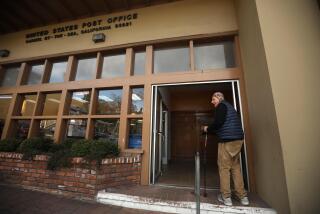New Area Codes Are Minor Rub
- Share via
Each new area code created--the Bay Area’s new 510, the upcoming 310 in Los Angeles--brings out both elegy and complaint. It’s not a creation but a “break-up,” a “split,” and those reassigned may take it personally, mourning their lost code as a “heritage,” a “way of life.”
They have practical concerns, needing to change stationery and inform customers or acquaintances, and some practical fears. Can they still reach 911? Will their neighbor be a toll call? But most of all, they feel altered. “Your phone number is one of the very first things you learn,” Pacific Bell spokesman Kate Flynn says. “You give it so often, it almost becomes like your name--it’s yours .”
Still, losing it isn’t tragic, or even unexpected, and it’s necessary if the system’s going to accommodate all the phones we want. We need new area codes because we’ve filled the old ones, what with all our phones and phone equipment. In Los Angeles, 40% of the prefixes assigned each year go to cellular phones and pagers. There are now nearly 5 million fax machines in the country, all needing numbers, as do many of the 30 million personal computers.
The North American Numbering Plan--our 10-digit dialing system--anticipated considerable growth when it was put together in the 1940s. It also anticipated direct dialing, in which number sequence alone automatically routes calls--the first three numbers (area code) identifying a geographic area, the second three (office code or prefix) identifying the local office and the last four an individual line.
The plan allowed for 152 possible area codes. They couldn’t start with 0 or 1, which had other uses, but had to have 0 or 1 in the middle to signal that eight numbers (a non-local call) followed. Thus there were 160 possible combinations (8x2x10, for the mathematically curious), less eight reserved for special uses (411, 911, etc.).
Each area code contained 640 possible prefixes. Those couldn’t start with 0 or 1 either and couldn’t have those digits in the middle because that signaled an area code (hence, 8x8x10).
Finally, there were 6.4 million possible lines per area code--10,000 groups of four digits (10x10x10x10) within each of the 640 prefixes.
“They thought the plan would go about 50 years,” says Ron Connors, district manager of the North American Numbering Plan Administration within Bellcore, the New Jersey research arm of the seven regional Bell companies. And it has. It’s not numbers but area codes that get used up. With some area codes in heavily rural states relatively empty, only a third of the 972 million possible numbers nationwide are being used. Other area codes have filled quickly. By 1992, 141 of the original 152 will be assigned, 12 just to California.
Some regions--including Los Angeles--avoided previous area-code splits by adding a magic “1” to area-code calls. This indicates that 10 digits follow, so with some exceptions, those 152 combinations previously reserved for area codes can now also be used as prefixes. The result: more than a million new seven-digit phone numbers, without hassle.
Area-code splits are a hassle, though phone companies struggle to avert it. They give the denser neighborhoods the old code (San Francisco proper keeps 415, downtown Los Angeles 213). Developing communities get the new one--510 for the East Bay, 310 for Los Angeles’ growing West Side.
Where possible, splits follow natural boundaries--the Santa Monica Mountains, the rim of Manhattan Island. Where there’s no natural boundary, and the boundaries of cities and phone offices don’t match, it’s more difficult. Some neighborhoods may be separated from their communities because their lines connect to a station now in the other code.
West Hollywood, for example, will be split between two codes in November: It wasn’t an incorporated city, or even a unified community, when the 310 split was planned in 1984. The city of Gardena’s business district will be split in two. Six blocks of Beverly Hills will stay in 213 with L.A. proper, losing what some see as the “prestige” of being in the new 310 with the rest of Beverly Hills.
Re-engineering those six blocks of lines to keep people and their prestige intact is possible, says Pacific Bell, but it could cost $1 million and require residents to change their seven-digit phone numbers--the seven digits most wrapped up with identity. What’s more, people want the phone company, clearly richer than they are, to absorb the cost, which it won’t.
Some people even suspect that phone companies split area codes in mid-city just to turn neighbor-to-neighbor calls into toll charges. Toll rates don’t always pertain to calls that cross long distances, area codes or even state lines, but they are typically “long-distance” calls and more expensive. Despite assurances that such calls will stay “local,” there’s no guarantee that those six blocks of Beverly Hills won’t some day find City Hall a toll call.
It’s a small price to pay for a numbering plan that seems infinitely flexible. Even when all 152 area codes are gone, there’s no problem. The magic “1” that made it possible to use area codes as prefixes also makes it possible to use prefixes as area codes--all 640 of them.
We can all have more phones, and more machines with more phones. But I’m not sure it’s such a gift.
More to Read
Sign up for Essential California
The most important California stories and recommendations in your inbox every morning.
You may occasionally receive promotional content from the Los Angeles Times.













